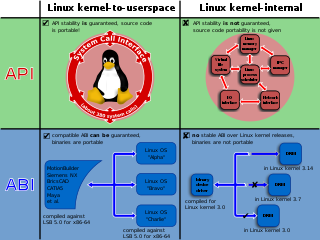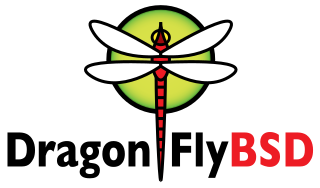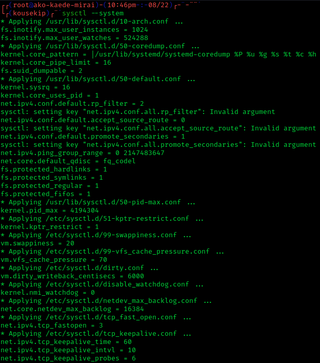Related Research Articles

An operating system (OS) is system software that manages computer hardware and software resources, and provides common services for computer programs.

A Commentary on the Sixth Edition UNIX Operating System by John Lions is a highly influential 1976 publication containing analytical commentary on the source code of the 6th Edition Unix computer operating system "resident nucleus" software, plus copy formatted and indexed by Lions, of said source code obtained from the authors at AT&T Bell Labs. It is also commonly referred to as the Lions Book.

In computing, a system call is the programmatic way in which a computer program requests a service from the operating system on which it is executed. This may include hardware-related services, creation and execution of new processes, and communication with integral kernel services such as process scheduling. System calls provide an essential interface between a process and the operating system.
The Unix file system (UFS) is a family of file systems supported by many Unix and Unix-like operating systems. It is a distant descendant of the original filesystem used by Version 7 Unix.

DragonFly BSD is a free and open-source Unix-like operating system forked from FreeBSD 4.8. Matthew Dillon, an Amiga developer in the late 1980s and early 1990s and FreeBSD developer between 1994 and 2003, began working on DragonFly BSD in June 2003 and announced it on the FreeBSD mailing lists on 16 July 2003.
tmpfs is a temporary file storage paradigm implemented in many Unix-like operating systems. It is intended to appear as a mounted file system, but data is stored in volatile memory instead of a persistent storage device. A similar construction is a RAM disk, which appears as a virtual disk drive and hosts a disk file system.
Light Weight Kernel Threads (LWKT) is a computer science term and from DragonFly BSD in particular. LWKTs differ from normal kernel threads in that they can preempt normal kernel threads. According to Matt Dillon, DragonFlyBSD creator:
The LWKT scheduler is responsible for actually running a thread. It uses a fixed priority scheme, but the fixed priorities are differentiating major subsystems, not user processes. For example, hardware interrupt threads have the highest priority, followed by software interrupts, kernel-only threads, then finally user threads. A user thread either runs at user-kernel priority, or a user thread runs at user priority.
DragonFly does preempt, it just does it very carefully and only under particular circumstances. An LWKT interrupt thread can preempt most other threads, for example. This mimics what FreeBSD-4.x already did with its spl/run-interrupt-in-context-of-current-process mechanism. What DragonFly does *NOT* do is allow a non-interrupt kernel thread to preempt another non-interrupt kernel thread.
The mainframe z/OS Operating system supports a similar mechanism, called SRB.
SRB's represent requests to execute a system service routine. SRB's are typically created when one address space detects an event that affects a different address space; they provide one of several mechanisms for asynchronous inter-address space communication for programs running on z/OS.
An SRB is similar to a Process Control Block (PCB), in that it identifies a unit of work to the system. Unlike a PCB, an SRB cannot "own" storage areas. In a multiprocessor environment, the SRB routine, after being scheduled, can be dispatched on another processor and can run concurrently with the scheduling program. The scheduling program can continue to do other processing in parallel with the SRB routine. Only programs running in kernel mode can create an SRB.
The Windows Operating System knows a similar light weight thread mechanism named "fibers". Fibers are scheduled by an application program. The port of the CICS Transaction Server to the Windows platform uses fibers, somewhat analogous to the use of "enclaves" under z/OS.
In UNIX, "kernel threads" have two threads, one is the core thread, one is the user thread.

Matthew Dillon is an American software engineer known for Amiga software, contributions to FreeBSD and for starting and leading the DragonFly BSD project since 2003.

Sixth Edition Unix, also called Version 6 Unix or just V6, was the first version of the Unix operating system to see wide release outside Bell Labs. It was released in May 1975 and, like its direct predecessor, targeted the DEC PDP-11 family of minicomputers. It was superseded by Version 7 Unix in 1978/1979, although V6 systems remained in regular operation until at least 1985.

NDISwrapper is a free software driver wrapper that enables the use of Windows XP network device drivers on Linux operating systems. NDISwrapper works by implementing the Windows kernel and NDIS APIs and dynamically linking Windows network drivers to this implementation. As a result, it only works on systems based on the instruction set architectures supported by Windows, namely IA-32 and x86-64.

sysctl is a software utility of some Unix-like operating systems that reads and modifies the attributes of the system kernel such as its version number, maximum limits, and security settings. It is available both as a system call for compiled programs, and an administrator command for interactive use and scripting. Linux additionally exposes sysctl as a virtual file system.
OS-level virtualization is an operating system (OS) virtualization paradigm in which the kernel allows the existence of multiple isolated user space instances, called containers, zones, virtual private servers (OpenVZ), partitions, virtual environments (VEs), virtual kernels, or jails. Such instances may look like real computers from the point of view of programs running in them. A computer program running on an ordinary operating system can see all resources of that computer. However, programs running inside of a container can only see the container's contents and devices assigned to the container.
The term "Research Unix" refers to early versions of the Unix operating system for DEC PDP-7, PDP-11, VAX and Interdata 7/32 and 8/32 computers, developed in the Bell Labs Computing Sciences Research Center (CSRC).
Data scrubbing is an error correction technique that uses a background task to periodically inspect main memory or storage for errors, then corrects detected errors using redundant data in the form of different checksums or copies of data. Data scrubbing reduces the likelihood that single correctable errors will accumulate, leading to reduced risks of uncorrectable errors.
There are a number of Unix-like operating systems based on or descended from the Berkeley Software Distribution (BSD) series of Unix variant options. The three most notable descendants in current use are FreeBSD, OpenBSD, and NetBSD, which are all derived from 386BSD and 4.4BSD-Lite, by various routes. Both NetBSD and FreeBSD started life in 1993, initially derived from 386BSD, but in 1994 migrating to a 4.4BSD-Lite code base. OpenBSD was forked from NetBSD in 1995. Other notable derivatives include DragonFly BSD, which was forked from FreeBSD 4.8, and Apple Inc.'s iOS and macOS, with its Darwin base including a large amount of code derived from FreeBSD.
In operating systems, a giant lock, also known as a big-lock or kernel-lock, is a lock that may be used in the kernel to provide concurrency control required by symmetric multiprocessing (SMP) systems.

The Berkeley Software Distribution or Berkeley Standard Distribution (BSD) is a discontinued operating system based on Research Unix, developed and distributed by the Computer Systems Research Group (CSRG) at the University of California, Berkeley. The term "BSD" commonly refers to its open-source descendants, including FreeBSD, OpenBSD, NetBSD, and DragonFly BSD.

Unix is a family of multitasking, multi-user computer operating systems that derive from the original AT&T Unix, whose development started in 1969 at the Bell Labs research center by Ken Thompson, Dennis Ritchie, and others.
The History of the Berkeley Software Distribution begins in the 1970s.
A virtual kernel architecture (vkernel) is an operating system virtualisation paradigm where kernel code can be compiled to run in the user space, for example, to ease debugging of various kernel-level components, in addition to general-purpose virtualisation and compartmentalisation of system resources. It is used by DragonFly BSD in its vkernel implementation since DragonFly 1.7, having been first revealed in September 2006, and first released in the stable branch with DragonFly 1.8 in January 2007. The long-term goal, in addition to easing kernel development, is to make it easier to support internet-connected computer clusters without compromising local security. Similar concepts exist in other operating systems as well; in Linux, a similar virtualisation concept is known as user-mode Linux; whereas in NetBSD since the summer of 2007, it has been the initial focus of the rump kernel infrastructure.
References
- 1 2 Lehey, Greg (2001), Improving the FreeBSD SMP implementation , retrieved 11 May 2018
- 1 2 3 "spl(9) - OpenBSD manual pages" . Retrieved 11 May 2018.
- 1 2 Lions, John (1976). Lions' Commentary on UNIX 6th Edition, with Source Code . p. 43.
- ↑ Lions, John (1976). Lions' Commentary on UNIX 6th Edition, with Source Code . p. 41.
- ↑ McKusick, Marshall Kirk; et al. (authors) (2004). The Design and Implementation of the FreeBSD Operating System. Addison-Wesley. p. 93.
- 1 2 "/sys/net/if.c". BSD Cross Reference. OpenBSD. 2019-03-01. Retrieved 2019-03-05.
s = splnet();
- 1 2 "/sys/net/if.c". BSD Cross Reference. NetBSD. 2019-03-01. Retrieved 2019-03-05.
s = splnet();